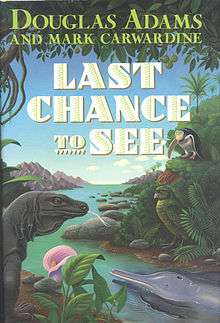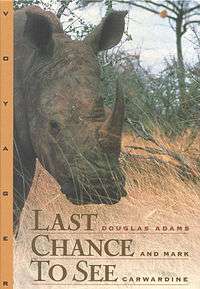Last Chance to See
 The front cover of the first US hardcover edition. | |
| Author | Douglas Adams and Mark Carwardine |
|---|---|
| Publisher | Pan Books |
Publication date | 1990 |
| ISBN | 978-0-345-37198-0 |
| OCLC | 26948233 |
| Genre | Wildlife documentary |
|---|---|
| Country | United Kingdom |
| Language(s) | English |
| Home station | BBC Radio 4 |
| Starring | Douglas Adams and Mark Carwardine |
| Air dates | October 1989 to November 1989 |
| Website | BBC Radio |
Last Chance to See is a 1989 BBC radio documentary series and its accompanying book, written and presented by Douglas Adams and Mark Carwardine. In the series, Adams and Carwardine travel to various locations in the hope of encountering species on the brink of extinction. The book was published in 1990.
In 2009, the BBC broadcast a television follow-up series of the same name, with Stephen Fry replacing the late Adams.[1]
In 1985, Douglas Adams went to Madagascar in search of the (possibly extinct) lemur the Aye-aye. The trip was part of a project by the World Wide Fund for Nature and British Sunday newspaper The Observer, sending well-known authors to remote places to seek endangered species and write articles for the paper's magazine, to help raise awareness of ecological issues. Adams was met in Madagascar by zoologist Mark Carwardine (who was working for the WWF at the time). The Observer project was successful, and Adams and Carwardine developed a radio series around the same concept for BBC Radio 4. Carwardine later said:
- "We put a big map of the world on a wall, Douglas stuck a pin in everywhere he fancied going, I stuck a pin in where all the endangered animals were, and we made a journey out of every place that had two pins."[2]
The journeys undertaken were to see:
- The aye-aye in Madagascar
- The Komodo dragon on the island of Komodo in Indonesia
- The kakapo in New Zealand
- The mountain gorilla in Zaire
- The northern white rhinoceros in Zaire
- The Yangtze river dolphin in China
- The Rodrigues fruit bat on the island of Rodrigues, Mauritius
- The Amazonian manatee in Brazil
- The Juan Fernández fur seal on the Juan Fernández Islands, Chile
Radio
The aye-aye programme was broadcast on BBC Radio 4 on 1 November 1985 as a pilot;[3] six further episodes were then broadcast in 1989:
- The kakapo - 4 October[4]
- The Yangtze river dolphin - 11 October[5]
- The Amazonian manatee - 18 October[6]
- The Rodrigues fruit bat - 25 October[7]
- The Komodo dragon - 1 November[8]
- The Juan Fernández fur seal - 8 November[9]
The mountain gorilla and northern white rhino, although the subject of a chapter in the book, did not feature in the radio series.
Book
In 1990, an accompanying book was published in the UK, describing the various adventures that duo had encountered on journeys, often with a comic tone. The book covers most of the radio episodes, but excludes the Juan Fernández fur seal and the Amazonian manatee, allegedly due to Adams' notorious writing delays. It includes some colour photographs taken by Carwardine.
The first American hardcover edition was published by Harmony Books in 1991 (under ISBN 0-517-58215-5) and the first German paperback edition was published in 1992 by Heyne (under ISBN 3-453-06115-2). These editions carry slightly different photographs of the journeys. An abridged audiobook, read by Adams, was also published.
Later editions of the book deleted two lines from the chapter on Komodo dragons: in the original edition, Adams asks Australian venomous reptile expert Dr Struan Sutherland, whether there are any venomous creatures that he likes, and the expert replies, "There was, but she left me." These lines are deleted in later editions, for reasons unknown.
In the posthumous biography and essay collection, The Salmon of Doubt, Adams describes Last Chance to See as his favourite work.
CD ROM

The Voyager Company also published a 2 CD-ROM set (for Microsoft Windows 3.1 and Macintosh System 6), in 1992, featuring over 800 still photographs, Adams reading the nearly complete book, Carwardine reading fact files on the species they searched like side bars, and extracts from the BBC Radio 4 series.
Television series
In 2009, the BBC broadcast a TV follow-up series, in which Stephen Fry, a friend of the late Adams, accompanies Carwardine on a journey to see what has changed in the 20 years since the radio broadcasts. The series excludes the Rodrigues fruit bat, the Yangtze river dolphin, which is "in all probability extinct", and the Juan Fernandez fur seal, which had proved embarrassingly easy for Adams and Carwardine to find.[10]
References
- ↑ "BBC Last Chance to See – Home – Last Chance to See". Retrieved 4 June 2009.
- ↑ "BBC Last Chance to See – About – Background". Retrieved 4 June 2009.
- ↑ "BBC - Last Chance to See - Radio - Natural Selection: In Search of the Aye-aye". Retrieved 1 November 2013.
- ↑ "BBC - Last Chance to See - Radio - Search for the kakapo". Retrieved 1 November 2013.
- ↑ "BBC - Last Chance to See - Radio - Search for the Yangtze river dolphin". Retrieved 1 November 2013.
- ↑ "BBC - Last Chance to See - Radio - Search for the manatee". Retrieved 1 November 2013.
- ↑ "BBC - Last Chance to See - Radio - Search for the Rodrigues fruit bat". Retrieved 1 November 2013.
- ↑ "BBC - Last Chance to See - Radio - Search for the Komodo dragon". Retrieved 1 November 2013.
- ↑ "h2g2 - Last Chance To See - the Radio Series and Book". Retrieved 1 November 2013.
- ↑ "BBC Last Chance to See – About – September 2008". Retrieved 4 June 2009.
Further reading
- Book extracts:
- "BBC Last Chance to See – About – Brazil extract". Retrieved 4 June 2009.
- "BBC Last Chance to See – About – Madagascar extract". Retrieved 4 June 2009.
- "BBC Last Chance to See – About – New Zealand extract". Retrieved 4 June 2009.
- Adams, D., Carwardine, M., Last Chance to See (Windows CD-ROM set), ISBN 1-55940-427-2 The Voyager Company, New York, 1992.
- Gaiman, N., Don't Panic – Douglas Adams & the Hitch Hiker's Guide to the Galaxy, ISBN 1-84023-742-2 Titan Books, London, 1993
- "BBC – h2g2 – Last Chance To See – the Radio Series and Book". Retrieved 4 June 2009.
External links
- Last Chance to See at BBC Programmes
- Douglas Adams: Parrots the Universe and Everything – Douglas Adams gives a talk centered around the book Last Chance to See